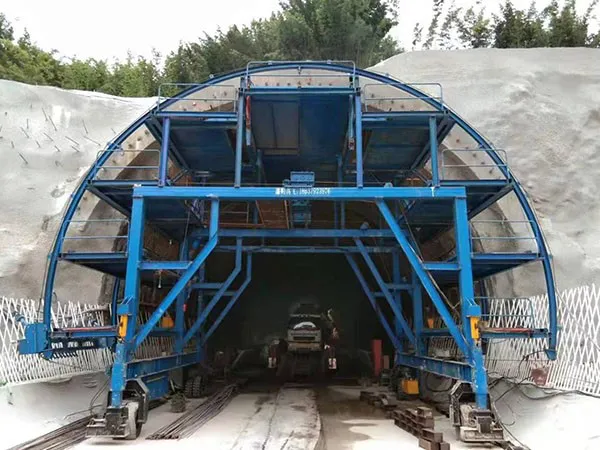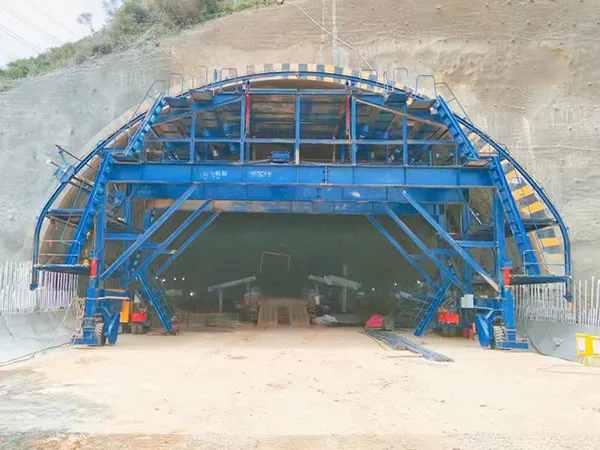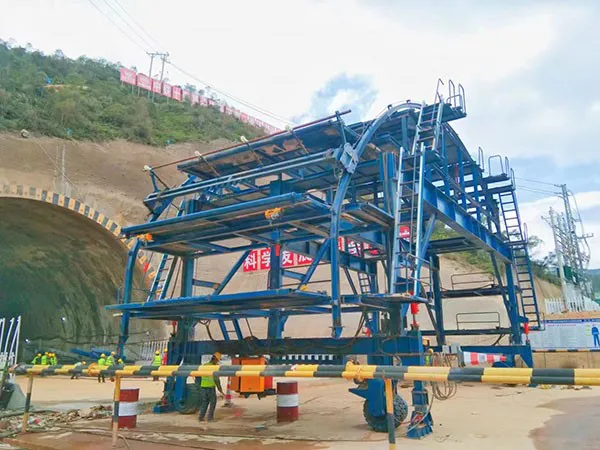Tunnel formwork operations present unique safety challenges due to the confined nature of the work, potential for ground instability, and the use of heavy equipment and materials. Adherence to stringent safety standards is crucial to prevent accidents, injuries, and fatalities.

Here's a breakdown of key safety standards and considerations for tunnel formwork operations, drawing from various regulations and best practices:
Competent Person: A "competent person" (as defined by relevant regulations like OSHA) must be responsible for carrying out and overseeing numerous safety requirements, including inspections, hazard identification, and implementing control measures.
Risk Assessment: A systematic process of identifying hazards, assessing risks, and implementing effective control measures is paramount. This includes:
Site Assessment: Evaluating the site for uneven terrain, overhead obstructions, environmental factors (e.g., adverse weather).
Hazard Identification: Recognizing potential for structural instability, falls, falling objects, manual handling injuries, and structural failures.
Emergency Planning: Developing and training personnel on emergency procedures, including evacuation plans, flood control, fire prevention, and rescue.
Communication: Effective communication systems (voice, power-assisted where natural voice is ineffective) must be maintained between the work face, shaft bottom, and surface.
Check-in/Check-out Procedure: A system to accurately track personnel underground is essential to ensure accountability in emergencies. At least one designated person must be on duty above ground.
Training: All employees involved in underground construction must be trained to recognize and respond to hazards. Training should be tailored to the specific job site and cover topics like:
Air monitoring and ventilation
Illumination
Communications
Flood control
Personal Protective Equipment (PPE)
Emergency procedures and evacuation plans
Check-in/check-out procedures
Explosives (if applicable)
Mechanical equipment
Safe operating procedures for specific tasks.
Regular Inspections: Routine inspections of formwork structures, equipment, and the work area are essential to identify signs of wear, damage, or instability. Rectification of issues must be prompt.
Documentation: Maintain records of safety inspections, training, and any incidents.
Design and Engineering:
Formwork must be designed by a qualified engineer and constructed from sound materials of good construction and adequate strength.
It must be capable of sustaining the total dead, live, and impact loads with a minimum safety factor (e.g., 2 in some regulations).
Do not deviate from layout drawings without the approval of a qualified designer.
Accurate load calculations are crucial to prevent overloading and collapses.
Erection and Dismantling:
All form components and hardware must be kept clean and lubricated for proper performance and inspection.
Components must be inspected regularly for damage or excessive wear.
Adequate temporary bracing must be in place during initial setting.
Formwork must be properly braced and stabilized against wind and other external forces.
Wall ties must be in place and secured per manufacturer's recommendations. Do not alter them.
When dismantling, a long crowbar is generally used, and no one should stand on the formwork being demolished. Prevent the entire formwork from falling.
If work stops midway during erection, supports, tie-in heads, and column head plates must be nailed firmly.
During dismantling intervals, movable formwork, traction bars, and supports should be transported away or stacked properly.
It is unsafe and unlawful for persons to occupy any form walkway while the form is being moved.
Access and Working Platforms:
Safe working platforms must be installed according to applicable safety standards (e.g., OSHA, local regulations).
Walkway systems must be properly positioned, spaced, and fastened per manufacturer's specifications.
Walkways must be in place along the upper level of formwork; workers must never attempt to walk or stand on top of forms.
Scaffold brackets must use manufacturer-recommended connectors.
Scaffold planks must meet minimum size and grade requirements (e.g., 2x10 nominal lumber, scaffold grade) and be securely fastened to prevent dislodgement.
Walkways and platforms must be equipped with guardrails, midrails, and toeboards along all open sides and ends.
Never allow persons to work on one level if others are directly below or overhead unless proper protection (e.g., safety nets) is provided.
Material Handling:
Heavy formwork materials and tools must be properly stored and secured to prevent falling objects.
Proper lifting techniques and appropriate equipment should be used to minimize manual handling injuries.
Reserved Openings: Any reserved holes on the formwork or concrete slab must be immediately covered after installation or removal to prevent falls.

Ground Support and Stability:
Portal openings and access areas must be guarded by shoring, fencing, head walls, shotcreting, or equivalent protection.
Subsidence areas must be similarly guarded.
Adjacent areas must be scaled or secured to prevent loose soil, rock, or fractured materials from endangering workers.
Before drilling or mucking, inspect the working surface (support, roof, sides) for firmness. Loose rocks should be supported or treated immediately.
Ventilation and Air Quality:
Adequate ventilation is crucial to remove polluted air, gases (e.g., carbon monoxide, carbon dioxide, flammable gas), and smoke.
Regular air monitoring to detect oxygen deficiency and toxic or flammable gases.
Measures to eliminate dust (e.g., dust collectors, water spray).
If diesel engines are used, they must have suitable filters/scrubbers. Petrol engines are generally prohibited.
Illumination: Adequate and reliable illumination must be provided throughout the tunnel.
Electrical Safety:
Electrical power circuits and wiring must comply with safety standards.
Bare wires and exposed live conductors are prohibited.
Appropriate protective devices (e.g., residual current circuit breakers) should be in place.
When using electric tools on metal formwork, apply safety voltage (e.g., below 36 volts) or take other effective safety measures.
Fire Prevention and Protection:
Comprehensive fire safety plans, including detection, suppression, and emergency procedures.
Strict control over hot work.
Adequate fire-fighting facilities and procedures.
Personal Protective Equipment (PPE):
All personnel entering the construction site must wear safety helmets.
Workers in dangerous or high-altitude operations must wear appropriate PPE, including safety harnesses, fall protection, safety glasses, gloves, steel-toed boots, and respiratory protective equipment (e.g., dust masks, electric fan respirators) when required.
Anti-vibration gloves and earmuffs/earplugs for noise protection.
Noise and Vibration: Measures to reduce exposure to noise and vibration from machinery.
Water Ingress and Flood Control: Measures to prevent and control groundwater ingress and flooding.
Emergency Exits and Shelters: Clearly marked evacuation routes, emergency exits, and shelter places in long tunnels.
Prohibition on Alcohol/Smoking: Strict prohibition on alcohol consumption and smoking underground.

Many countries and regions have specific regulations governing underground construction and formwork. Examples include:
OSHA (Occupational Safety and Health Administration) in the US: The OSHA underground construction regulation (29 CFR 1926.800) covers requirements for safe access/egress, training, check-in/check-out procedures, and emergency plans.
Workplace Safety and Health (Construction) Regulations in Singapore: These regulations detail requirements for formwork structures, including material quality, strength, bracing, inspection, and the duties of competent persons and formwork supervisors.
SafeWork Australia (Australia): Provides guides for tunneling work that emphasize managing risks through hazard identification, risk assessment, control measures, and regular review.
It is crucial for contractors and workers involved in tunnel formwork operations to be thoroughly familiar with and strictly adhere to all applicable national, regional, and site-specific safety regulations and industry best practices.
Gaofei
Address: 200m east of tulip garden, group 12 of zhangling community, hongshan street office, hongshan town, xigong district, Luoyang
Tel: +8616638856888
Contact: Gaofei Huang
Mobile: +86-18637923976
Phone: 0379-80881719/ 0379-60162687
QQ: 286827457
E-mail: gaofei@gf-bridge-tunnel.com